Posts Tagged: mimics
The Beckoning Bees at Bodega Bay
Head to the Bodega Bay in Sonoma County and you'll see little kids building sandcastles on the beaches. But head to Bodega Head in the spring...
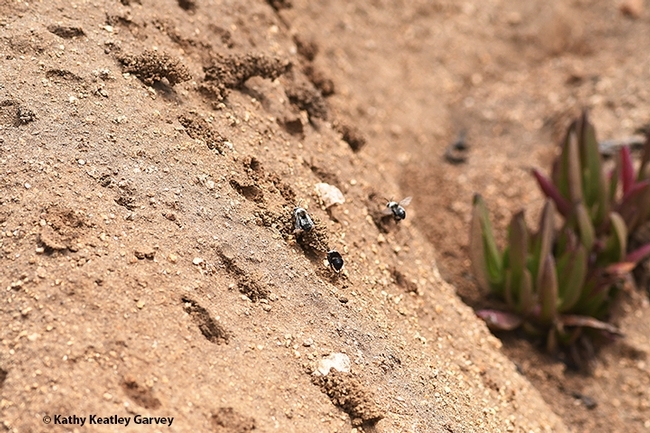
Digger bees, Anthophora bomboides stanfordiana, building their nests in the sand cliffs off Bodega Head. (Photo by Kathy Keatley Garvey)
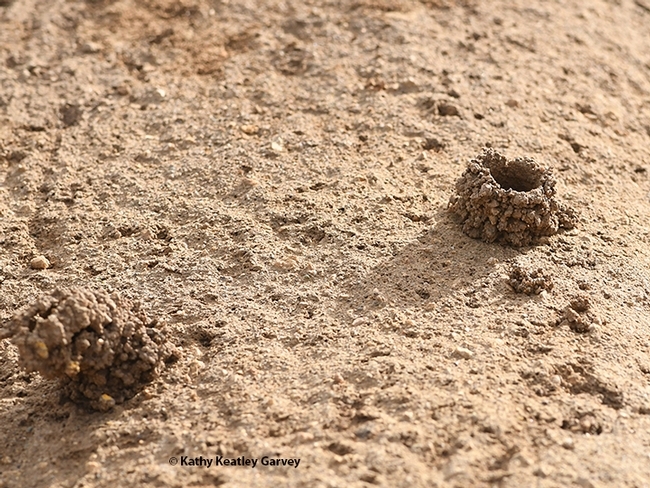
These are the turrets, aka "sandcastles," that digger bees build in the sand cliffs off Bodega Head. (Photo by Kathy Keatley Garvey)
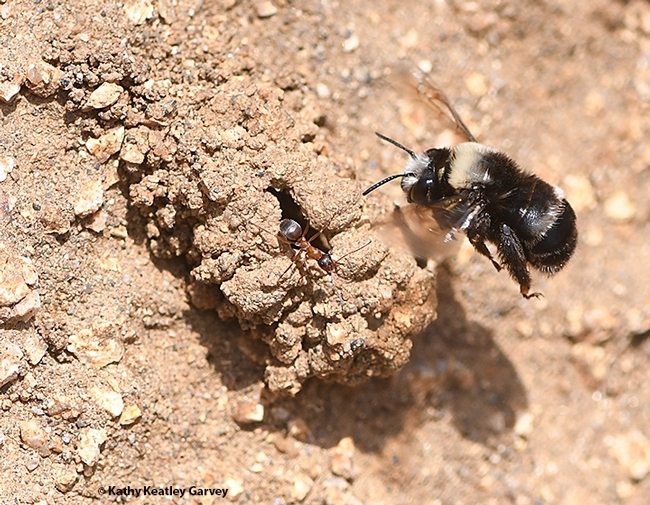
A digger bee, Anthophora bomboides stanfordiana, heading toward her nest at Bodega Head. (Photo by Kathy Keatley Garvey)
The Bees of Bodega Head
There's more to Sonoma County's Bodega Head than the stunning views, crashing waves, nesting seabirds, and bursts of flora and fauna. The...
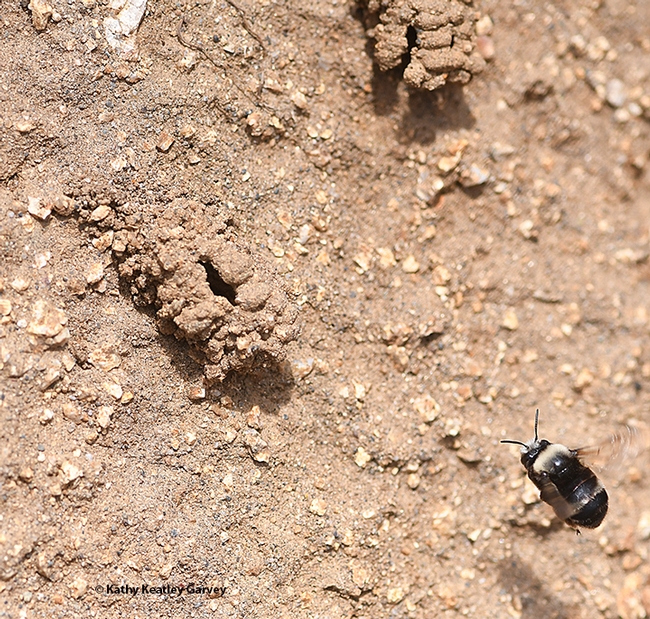
A digger bee, Anthophora bomboides stanfordiana, returning to her nest on the sand cliffs of Bodega Bay. (Photo by Kathy Keatley Garvey)
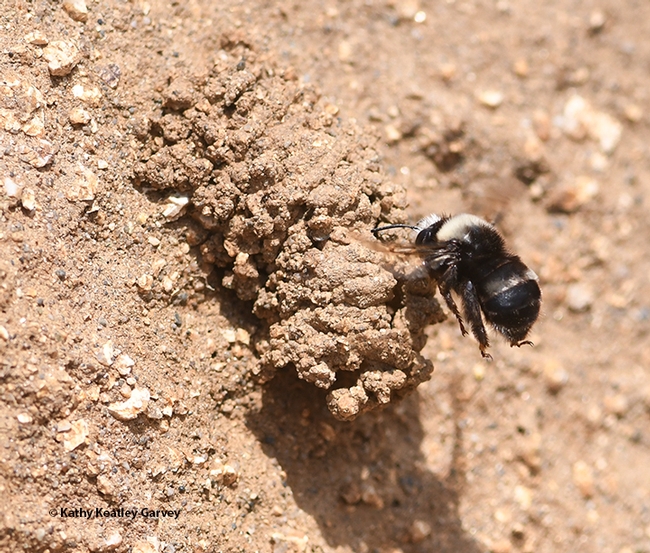
A digger bee, Anthophora bomboides stanfordiana, edges closer to her nest on the sand cliffs of Bodega Bay. (Photo by Kathy Keatley Garvey)
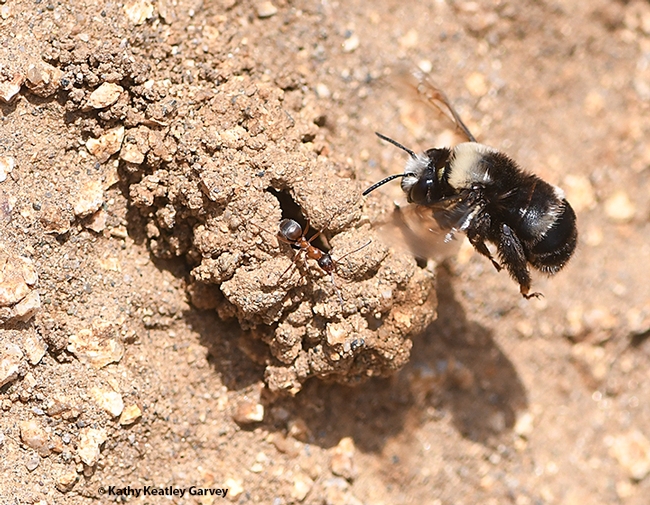
A bee-ant encounter: The digger bee, Anthophora bomboides stanfordiana, encounters an ant, Formica transmontanis, as identified by ant specialists Phil Ward and Brendon Boudinot of UC Davis. Both species nest on the sand cliffs. (Photo by Kathy Keatley Garvey)
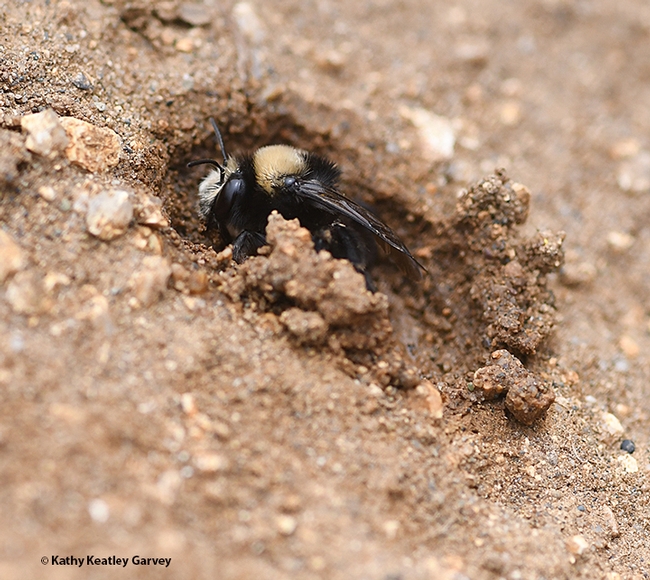
A digger bee, Anthophora bomboides stanfordiana, excavating a nest on the sand cliffs of Bodega Head. (Photo by Kathy Keatley Garvey)
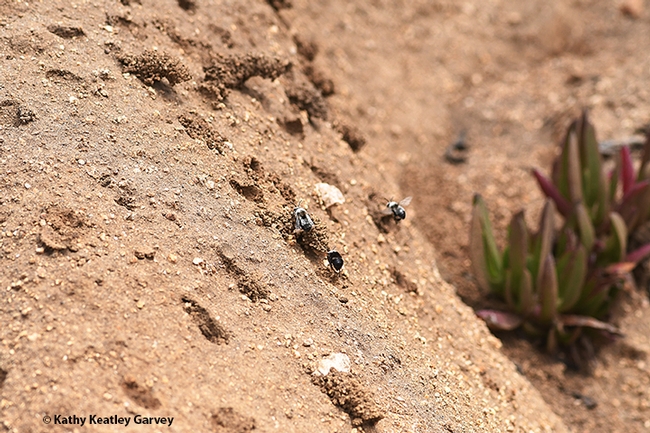
Four digger bees, Anthophora bomboides stanfordiana, appear in this image at Bodega Head. (Photo by Kathy Keatley Garvey)

A view from Bodega Head. Most tourists are unaware of the digger bees that inhabit the sand cliffs. (Photo by Kathy Keatley Garvey)
This Hover Fly Engages in Identity Theft
The wonderful world of insects... Have you ever seen a syrphid, aka hover fly or flower fly, that resembles a bumble bee? Volucella bombylans is a...
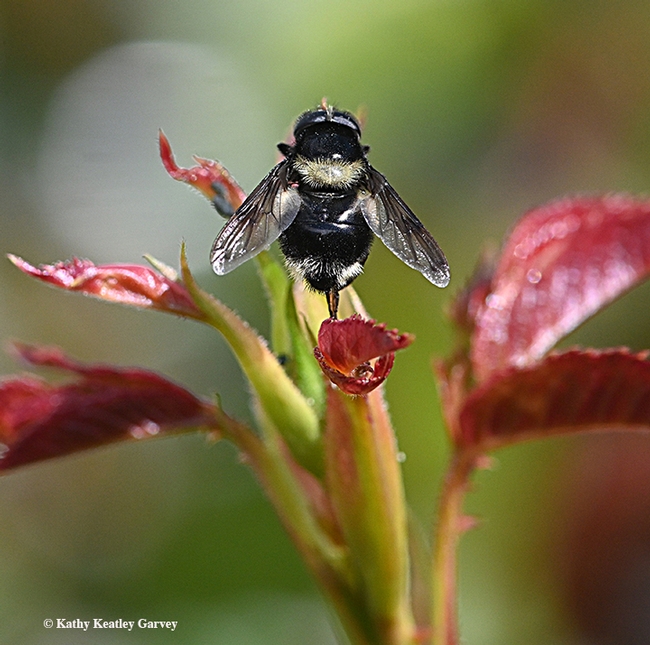
A hover fly that's a bumble bee mimic: this is Volucella bombylans complex. (Photo by Kathy Keatley Garvey)
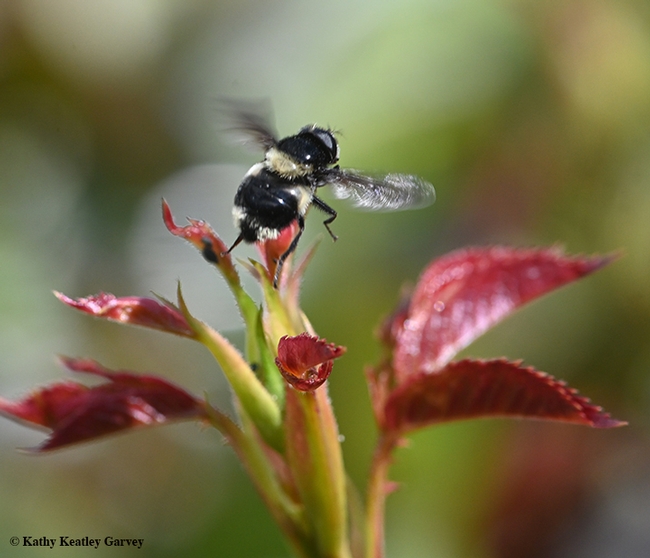
The hover fly, a Volucella bombylans complex, departs its perch. (Photo by Kathy Keatley Garvey)
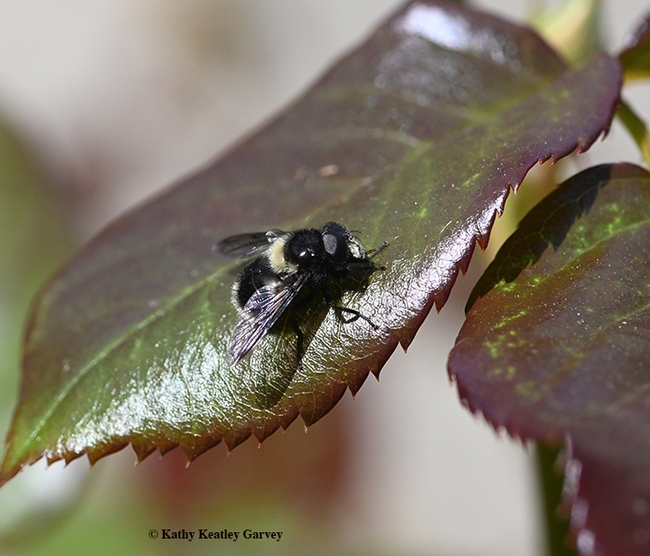
It's a fly; not a bee! Side view of the syrphid fly bumble bee mimic, Volucella bombylans complex. (Photo by Kathy Keatley Garvey)
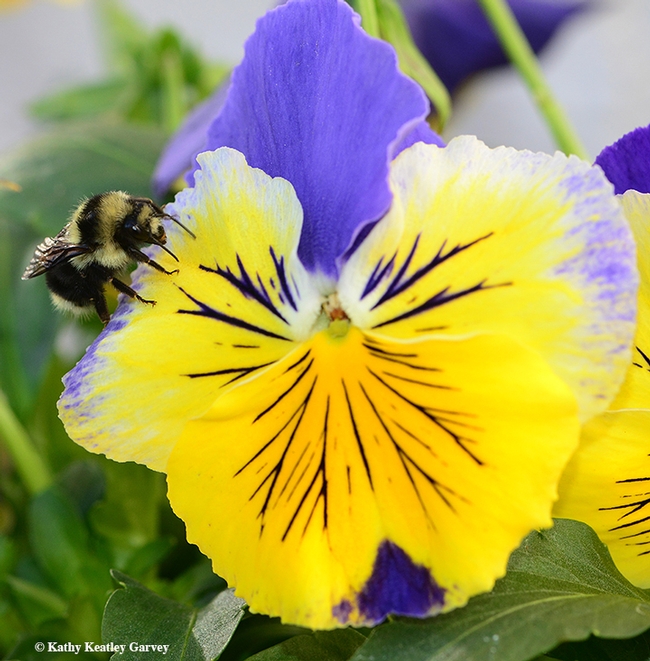
A bumble bee, Bombus melanopygus, investigates a pansy. This image was taken in Vacaville, Calif. (Photo by Kathy Keatley Garvey)
A Mockingbird Can Change Your Tune
Until last year, the noisy Northern Mockingbird (Mimus polyglottos) irritated me. Flitting from limb to fence to rooftop, this shrill impersonator of other birds’ song and sounds was not welcomed in my garden. But that was before a family of 10 moved into the neighborhood right across the street from my house and brought with them four felines that roam free 24-7. Needless to say, these cats prowl my front, side and backyard for birds. Within days, the seed feeders I had tacked atop fence posts and the bird baths I'd placed in the flowerbeds sat empty. No Towhees, Gold Finches or Robins. No Quail or Doves. Not even a Blue Jay or House Sparrow.
Now when I sat at my kitchen table sipping my morning coffee, I look out the window at cats slinking along the header of the wooden fence. Instead of enjoying the daily ritual of birds scratching the soil and sifting through leaves for insects, I see cats hiding behind bushes hunting for a feathered meal. Four uninvited cats licking their chops and leaving behind their business. Needless to say I'm one unhappy gardener. Yet what bothers me most is that I miss the twitter and squawk, the chatter and the chirp of bird song.
Until yesterday, I thought my days of listening to cheeps, coos and trills are history. Then out of the blue, a “many-tongued mimic” flitted into my backyard. Guess what? I was so excited to see a Mockingbird that I vowed never again to grouse about its mating call, even it woke me up at 2 a.m. This weekend I plan to rummage through the garage for paint to construct a small garden sign that reads:
ALL feathered friends welcomed here — even Mockers, Mimics and Misfits
Here are a couple of tidbits you might find interesting about the Mockingbird.
• The Latin name (Mimus polyglottos) really does mean “many-tongued mimic.” Recognized calls of the Mockingbird are: Hew call used to warn of nest predators and interaction between mates. Chat (used year-round when disturbed) or chat burst (specific to fall and used in territorial defense). Nest relief call and the begging call (used only by males).
• An omnivore that forages through vegetation and on the ground. Both male and female look alike, nest build, and are socially monogamous.
• The State bird of five states, known for its ability to recognize previous threats and intruders (including humans) and to return to prior breeding grounds. Today more Northern Mockingbirds live in urban habitats than rural areas and are considered a positive species.
For me, the very presence of this fascinating intelligent bird triggers an age-old in-depth conversation. Personally, I am at a loss for words, a good thing lest I write something naughty about the neighbors. Certainly, the Mockingbird’s reappearance in my yard is helping me change my tune about this amazing bird. But I can’t say the same about the cats. As a former “responsible” cat lover-owner who appreciates pets, I must be honest about these neighborhood free roamers. Seems to me that gardeners have little voice on the block to truly convey the environmental, emotional and spiritual impact of losing the sweet simple melody of their garden.
Yet maybe, in time, with enough cats as mentors, Mockingbirds will learn to meow. Now that’s a thought to ponder. I mean, can you imagine a 2 a.m. repertoire of screeching feline frenzy?
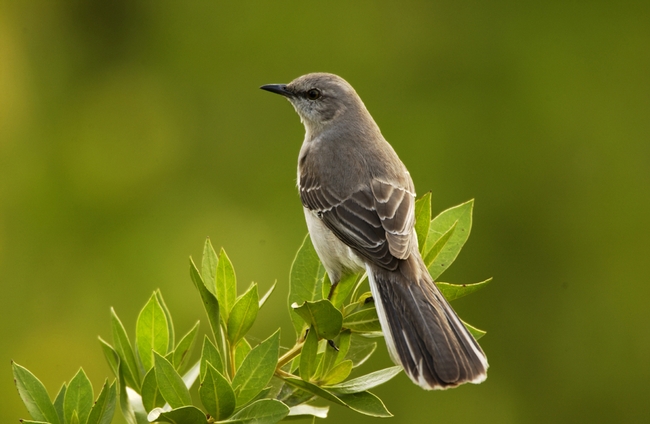
Mimus polyglottos (courtesy of Wikipedia.org)

